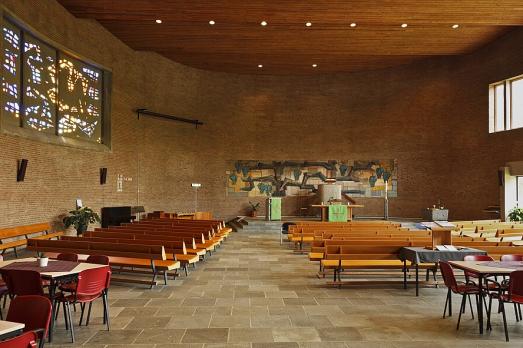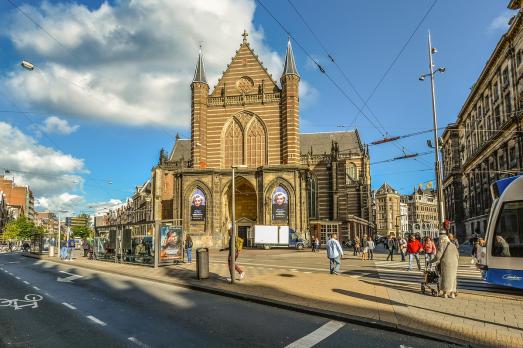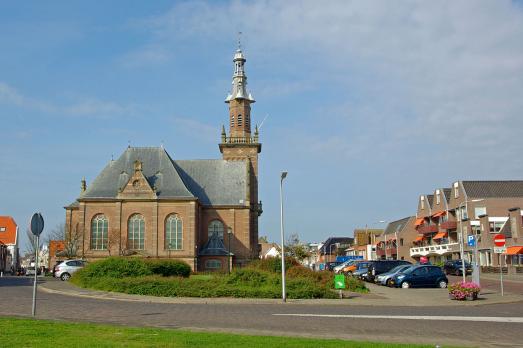Nieuwe Kerk
Huizen, NL
Important interbellum church with tower. Renovated 1993. Reformed Federation church.
Here you can search for a building to visit. You can use the map find destinations, or you can use the filters to search for a building based upon what different criteria.
Huizen, NL
Important interbellum church with tower. Renovated 1993. Reformed Federation church.

Arnhem, NL
Built as the Reformed Resurrection Church. Architecturally extremely important modern church building with tower. Nominated in 2013 and registered as a national monument in 2015. This church contains various objects, including several stained glass windows, from the Dutch Reformed Pniël Church, which was demolished in the late 2000s.
Ede, NL
Important, well-preserved, large interbellum church with a roof turret at the crossing.
Borne, NL
The church was the second reformed church of Borne and is located in the western extension. Characteristic example of protestant church building from the interbellum. The church has recently been renovated internally and externally (see photos).
Middelburg, NL
Unique historical complex. Rebuilt / reconstructed after heavy war damage in 1940. This church is listed as a National Monument of the Netherlands.
Amsterdam, NL
Remonstrant church "Nieuwe Kerk", later called "Vrijburg", with outbuildings in the Herman Gorterstraat.The congregation came from the 'old' Remonstrant church on the Keizersgracht, now Rode Hoed. In the 1930s, architect Roodenburgh was also involved in the renovation of a (now demolished) Remonstrant church in Leiden.

Amsterdam, NL
The Sint-Nicolaaskerk (old church) was inaugurated at the end of the 14th century. The building was damaged by the city's fire of 1421 and 1452, but more seriously by the fire of 1645, after which date most of the interior. After the Alteratia of 1578, the church became Protestant. The Nieuwe Kerk, since 1814, is used for royal investitures and weddings. Nowadays, it is also one of the main exhibition centres in Amsterdam.

Katwijk aan Zee, NL
The New Church in Katwijk was a replacement of the former Andreaschurch, which had become too small. The construction started in 1885 and it took two years to finish everything. The current building is the oldest and best-known work of the Dutch architect H. J. Jesse (1860-1943).
Groningen, NL
Cruciform renaissance church with roof turret. One of the most monumental church buildings built in the 17th century as a Protestant church.
Rotterdam, NL
Church and hall complex from 1952, designed by B. van Heyningen and B. Uyterlinde, built for the Reformed Church of Rotterdam-Centrum, to replace the Nieuwe Oosterkerk that was destroyed in 1940. Church hall, built in concrete skeleton construction in modernist forms, with a gallery running around on three sides, consisting of six bays, each with its own internally visible tent roof covering. Semi-detached openwork concrete tower. Modernised liturgical centre, pew plan from the construction period. Since around 1967, the Reformed Church in the Netherlands held services in the Reformed Nieuwe Oosterkerk, even after the sale of this church building to the Pentecostal Church of Capelle aan den IJssel in 1981. This church was founded after the ecclesiastical schism of 1953 in the Reformed Church, in which around 100 members and baptised members from the local Reformed Church transferred to this church association. This department of the Reformed Church in the Netherlands was abolished in 1999.

new
The Chassidic Route is a cultural and historical trail tracing the rich legacy of Jewish communities in southeastern Poland and western Ukraine. This region was central to the rise of Chassidism in the 18th century. Here, we highlight 10 remarkable synagogues you’ll discover along this route.

he cradle of the Industrial Revolution in Germany, Chemnitz, is well-known for its industrial heritage landscape, but the city is also home to remarkable examples of religious architecture from different historical periods. Join us as we explore the key landmarks of this European Capital of Culture 2025.

The twin towns of Nova Gorica (Slovenia) and Gorizia (Italy), lying on the border between the two countries, have a rich religious heritage, steeped in centuries of tradition. If you are looking for ideas for your visit, take note of these 10 religious sites that you should not miss.